Form 0920-1050 Shiriki Protocol New Member_Webinar Feedback Form
[OADC] CDC Usability and Digital Content Testing
Protocol_Shiriki community_Nov 2023
[CGH] Shiriki Virtual Community Annual Planning Survey
OMB: 0920-1050
|
|
|
Protocol Shiriki Virtual Community
*Contacts: Name: Dana Dolan |
Role: Lead Administrator |
Title: Technical Writer |
Address: 1600 Clifton Rd. |
Country: USA |
Telephone: 678-467-4098 |
Email: DDolan@cdc.gov |
Principal Investigators and co-investigators
Name and SEV# |
PI/Co-PI |
Title and Institution |
Roles and Responsibilities |
James Kariuki SEV# 1751 |
PI |
Service Fellow- Division of Global HIV and TB Centers for Disease Control and Prevention |
PI, and co-administrator, and subject matter expert, provides context for technical topics; advises on administrative matters and programming; conduct data analysis |
Dana Dolan |
Co-PI |
Technical Writer, TEKsystems |
The lead administrator of Shiriki, manages membership, coordinate schedule and programming; communicates with contributors |
Neranga Liyanaarachchige |
Co-PI |
Division of Global HIV and TB Centers for Disease Control and Prevention |
Co-administrator and subject matter expert, provides context for technical topics; advises on capacity development aspects of programming; advises on administrative matters |
ABBREVIATIONS
CoP: Community of Practice
GEEKS: Growing Expertise in E-Health Knowledge and Skills
HIT: Health Informatics Team
I-LEAD: Inter-governmental Learning Exchange to Advance Data-driven Decision-making
MoH: Ministry of Health
TAP: Technical Assistance Platform
WHO: World Health Organization
Contents
Contents
Participation and Communication 6
Intro to Shiriki Presentation 9
Potential risks resulting from participation are minimal. 10
APPENDIX 1: New Member Form 11
APPENDIX 2: Webinar Feedback Form 12
Overview
Project Summary
Shiriki (from the Swahili word for “sharing”) is an informal, collaborative, information and knowledge sharing space centered around health informatics in global health. It began after colleagues from several PEPFAR-supported countries, working together at CDC Headquarters in Atlanta, expressed a desire to continue their conversations about similar digital-health challenges across similar project contexts, even after they had returned home. We created a virtual community of practice (CoP), Shiriki, for our counterparts working in different countries to informally discuss and share their work. Membership in the Shiriki community is open and the materials produced are publicly accessible.
Since its inception in 2018, Shiriki has grown into a CoP with >1,200 members in 49 countries, spanning 6 continents. Although Shiriki is hosted at CDC, content is driven by the community allowing its diverse group of members to share their knowledge, expertise, and experience with other subject matter experts. The focus of the CoP is on activities that address digital-health priorities including Health Information Exchange, interoperable systems, efficient electronic data systems, workforce development, and medium- and longer-term strategic planning. Through these interactions, both live and asynchronous, participants share their expertise and experiences to help build a collaborative knowledge base and reduce redundant efforts across countries. We encourage intersectoral collaboration to solve digital health problems.
Shiriki is not a source of official guidance from CDC, US Government, or country government, even when CDC, USG, or country staff participate in Shiriki activities. Because of its nature as a collaborative space, Shiriki is not a communication channel for any particular organization. That said, the Shiriki community overlaps with the target audience for many endeavors in the digital-health space, and community members are welcome to share updates or information about upcoming or recent events as appropriate.
Shiriki is not a resource for continuing-education certification.
Shiriki Core Team is not responsible for generating content shared through the community.
Sponsor Monitoring
As the study sponsor, the Centers for Disease Control (CDC) may conduct monitoring or auditing of study activities to ensure the scientific integrity of the study and to ensure the rights and protection of study participants. Monitoring and auditing activities may be conducted by:
CDC staff (“internal”)
authorized representatives of CDC (e.g., a contracted party considered to be “external”)
both internal and external parties
Monitoring or auditing may be performed by means of on-site visits to the Investigator’s facilities or remotely through digital platforms or other communications such as telephone calls or written correspondence. The visits will be scheduled at mutually agreeable times, and the frequency of visits will be at the discretion of CDC. During the visit, any study-related materials may be reviewed and the Investigator along with study staff should be available for discussion of findings. The study may also be subject to inspection by regulatory authorities (national or foreign) as well as the IECs/IRBs to review compliance and regulatory requirements.
Introduction
E-health development is a complex human activity requiring coordination of efforts, strategic use of time and resources, and creative thinking and problem solving to achieve goals. In this context, development goals include establishing informatics governance and leadership, developing effective health information systems, and developing a competent e-health workforce.
One of the key areas in which informatics capacity will contribute to enabling effective use of health information systems is the development of local and regional CoPs. According to Wenger1, CoP members’ negotiation of meanings in practice leads to the development of three structural elements of CoPs: mutual engagement (how and what people do together as part of practice), joint enterprise (a set of problems and topics that they care about), and shared repertoire (the concepts and artifacts that they create). Shiriki is a virtual community of practice for persons who work in global health informatics, specifically those engaged in the fight against human immunodeficiency virus (HIV) as funded by the US President’s Emergency Plan for AIDS Relief (PEPFAR).
Background
Shiriki (a Swahili word that means “sharing”) began in 2018, after representatives from several PEPFAR-supported countries attended a weeklong training course, I-LEAD, on e-health development at CDC Headquarters in Atlanta, Georgia. During the week, participants from Uganda and Nigeria used the opportunity to share their experiences and challenges in the realm of public health informatics and expressed a desire to continue their conversations even after they had returned home. Because there is no structure for informally doing so, a team of staff working at CDC headquarters in the Health Informatics, Data Management, and Statistics Branch (HIDMSB) explored ways to keep their colleagues in contact and foster conversations in such a way that Headquarters staff were not the primary source of information. Rather, the experts would be the CDC staff working in countries around the world and the staff of government entities, universities, and private-sector partners with whom they collaborated.
Methods
Community Design
Shiriki is designed such that CDC HQ staff can facilitate information sharing but are not the primary source of information.
Population
Initial membership was the participants in the 2018 training course, who came from Uganda, Nigeria, and Cameroon; the CDC laboratory points of contact in each PEPFAR-supported country; members of the HIDMSB staff who worked on the Health Informatics Team; and CDC field staff known to the Health Informatics Team (total 117 persons).
New members were added primarily through recommendations by colleagues, attendance in the HIT-led training programs I-LEAD and GEEKS; and participation in projects related to TAP. Membership is defined loosely as persons working on PEPFAR-supported activities related to global public health informatics. Members of the community include country public health administration (MOH, MOPH, DoH&W, etc.); CDC staff based in Atlanta and in country offices; and our colleagues in the businesses, universities, and nongovernmental organizations that help to implement solutions.
An upper limit for participants has not been set, but would be the maximum number of email addresses allowed on the Listserv tool. Some members have registered more than one email address.
Participation and Communication
Shiriki uses a listserv to communicate and distribute information via email. To be included in the members list for participation in Shiriki, first and last name and email address are required. For community administration, we request also each member’s organization name and type, country, and how they found out about Shiriki. Individual participant data are not shared beyond the Shiriki core team responsible for communication with the participants. Data are stored in an Access database to facilitate analysis.
Participant Lists
After a HIT-sponsored event (such as I-LEAD), at the event lead’s discretion, we add participants to Shiriki if they are not already members. These lists usually include participant name, email, organization, title, and country.
Membership Form
We use a Survey Monkey form (Table 1; Appendix 1) to request information from participants. Once the form is completed, the participant’s email and name are added to the Listserv, and all information added to the Access database to facilitate analysis of webinar participation from countries.
Webinar Materials
Slide decks, notes, and recordings from webinars are stored in a CDC-hosted Sharefile repository. The URL is changed several times a year. Anyone may access these materials. Sharefile collects username and email and generates usage reports on demand, enabling the core team to cross-check who is accessing the materials and when.
Webinar attendance is currently tracked by Zoom as attendee-submitted name and email.
Webinar Feedback
After each webinar, we use a Survey Monkey form (Table 2, Appendix 2) to gather evaluation data anonymously. That form collects qualitative evaluation on the content and presentation of the event using Likert scale, any additional comments as freeform text, and participant’s country and role.
Annual Member Survey
We distribute to the members a survey (Table 3, Appendix 3) for members to evaluate usefulness of the community and offerings and to make suggestions for programming. This survey is anonymous although we request that participants who suggest a future webinar topic include name and email for follow up.
Table 1: Membership form data elements and the use
Data Element/Item |
Purpose/Use |
Thank you for your interest in Shiriki, an informal community of people who work in global public digital health. We ask for some information to know who's in the community and what type of work you do; this helps inform our programming. We may share aggregated data beyond this community. We won't share your personal information. |
Description of the form |
Are you joining Shiriki or updating your information?
|
Use to analyze # of new or re-joining members |
Name |
To add to the Listserv for communication purposes |
Primary Email |
|
Alternative Email |
|
Affiliation Organization Name |
To analyze/aggregate membership based on their affiliation |
Organization Type
|
|
Source (how did you hear about Shiriki?)
|
To analyze/aggregate membership based on how they heard about Shiriki, to improve our reach |
Country |
To analyze/aggregate membership based on their country of interest/work |
Table 2: Webinar feedback form data elements and the use
Data Element/Item |
Purpose/Use |
Thank you for attending this session. We appreciate your feedback. Your responses are anonymous and will help us improve Shiriki programming. We may share aggregated data; we won't share your personal information. If you are not a member of the Shiriki community and would like to be added, please go to the membership form after completing this survey. You will find that form at https://www.surveymonkey.com/r/5VVWVFP (You might need to copy the link and paste it into your browser.) |
Description of the form |
The content of this session was well organized and clearly presented. |
Aggregate analysis of feedback on organization of the webinar and the content shared. |
Something I heard or saw in this session will help me think of my work in a different way. |
|
Participating in this session was a productive use of my time. |
|
Comments about the session: |
To analyze comments to identify suggestions to improve/change the webinar process or the content. |
I would like to know more about the following topic(s) not addressed during the presentation (please add your name and email if you would like us to follow up): |
For specific follow up and connecting with the presenters. |
I work in or with this country/countries: |
To analyze/aggregate feedback based on their country of interest/work |
I work for:
|
To analyze/aggregate feedback based on their affiliation |
My job title or area of expertise is (check all that apply):
|
To analyze/aggregate feedback based on their expertise |
Table 3: Annual survey form data elements and the use
Data Element/Item |
Purpose/Use |
We are gathering information for planning upcoming Shiriki webinars, spotlight articles, and conversations. We will report our findings back to the community, and we may share aggregated data beyond this community. We will not share your personal information. In 2022, topics we covered included EMRS usage, master patient index and client registry, case-based surveillance, machine learning, and human resource information systems. Previous newsletters and webinar materials can be found at our ShareFile site.
|
Description of the form |
Please
tell us which topics below are of current interest to you,
using the following scale:
Training, education, or mentorship programs |
Identify the priority/most important topics for the membership. |
Are you interested in learning about a specific topic? Please tell us the topic. |
To capture other interest areas. |
Are you interested in presenting a webinar on a specific topic? [Y/N] If yes: If you are interested in presenting a webinar or series, please tell us the topic. |
Identify those who would like to present/conduct a webinar |
For planning purposes, please give the time period in which you would like to present (examples: after mid-March, July-August, any time) |
To identity a potential time frame. |
Your email: |
To contact/follow up on the interest to present. |
In which country do you do most of your work? [dropdown box of countries; “other” |
To connect with other experts who would potentially show similar interests in the country. |
Which of these best describes your organization?
If you are affiliated with an agency, please select the agency:
|
Identify and group which organizations the annual survey respondents are from to better plan the topics for the webinars. |
Data Management
After each event, we download the attendance list to identify member participation. We also download the survey result at end of week. We add new members to the listserv as requested and in the database.
We review and clean the member data approximately quarterly to ensure that it accurately reflects the contents of the Listserv. We also check for nonessential member data (country, organization, source) and add if missing. Data retention is in accordance with CDC record management and data retention policies.
Data Analysis
We compare webinar attendance to the member list to determine the makeup of webinar audiences as well as level of engagement of members. Please refer to the Table 1,2,3 (Column 2) for more details on how we use each data element, including analysis.
Additional planned analysis includes
Number of participants from DGHT countries
Level of participation from organizations:
Number of members who signed up, attended webinars, submitted newsletter articles
Number of webinars presented
Level of participation on the listserv
Number of journal articles shared
Topics suggested to elicit discussion or collect feedback
Dissemination
Shiriki communication channels are the HIGH-5 quarterly updates; CDC-HIGH-5 listserv; and community-driven webinars. Any member of the community can share information via these channels.
Annual Survey
The team shares results of the annual survey in a webinar. Slides are posted in the repository. A report appears in the quarterly update.
Marketing Single-Sheet
A handout is updated periodically to reflect current membership (total and location of members) and the current repository URL (Supplement).
Intro to Shiriki Presentation
Shiriki team has prepared a brief slide set on the history and benefits of Shiriki membership that is shared at I-LEAD or other training events. It is updated as appropriate.
Ethical Considerations
PII Collection and Use
The minimum data needed to add someone to the community are their name and email address. Those are used to subscribe the user to the CDC-hosted Shiriki listserv; data security is as standard on the listserv tool.
Personally identifiable information collected is retained by the Shiriki Core Team on its SharePoint site. Individual-level data are not shared. Data are aggregated and then shared after the annual survey. Data collected from webinar feedback and from the membership request are also aggregated for analysis.
Potential risks resulting from participation are minimal. Collection tools vetted by or housed at CDC and subject to existing security measures. We use a CDC license for SurveyMonkey to create the member form, feedback survey, annual survey, and webinar proposal form. We store materials from webinars, as well as the quarterly update, on a Sharefile (Citrix) repository housed at CDC. To access files, visitors must provide their name and email address. We use Zoom for webinars: CDC /government account collects name and email to register participants for webinars. Data retention for all is in accordance with CDC record management and data retention policies.
Informed Consent
Community membership is optional and participants may leave the group at any time.
Statements on each form
Membership request form: “We ask for some information to know who's in the community and what type of work you do; this helps inform our programming. We may share aggregated data beyond this community. We won't share your personal information.”
Webinar feedback request form: Responses are anonymous and we do not present the option of self-identification. Instructions include: “Your responses are anonymous and will help us improve Shiriki programming. We may share aggregated data; we won't share your personal information.”
Non-members are invited to join the community but not required to do so: “If you are not a member of the Shiriki community and would like to be added, please go to the membership form after completing this survey. [ link to form]”
Annual community survey: “We are gathering information for planning upcoming Shiriki webinars, spotlight articles, and conversations. We will report our findings back to the community, and we may share aggregated data beyond this community. We will not share your personal information.” If respondent indicates they would like to present on a particular topic, there is an optional question for name and email. We use that information to follow up with respondent and invite them to schedule a webinar.
Webinar attendees are informed at the start of a webinar that the session will be recorded and may choose to leave the meeting and access the recording later (Appendix 4). After 1 year, the webinar recordings are deleted from the publicly accessible Sharefile site.
Data retention is in accordance with CDC record management and data retention policies.
Appendices
APPENDIX 1: New Member Form
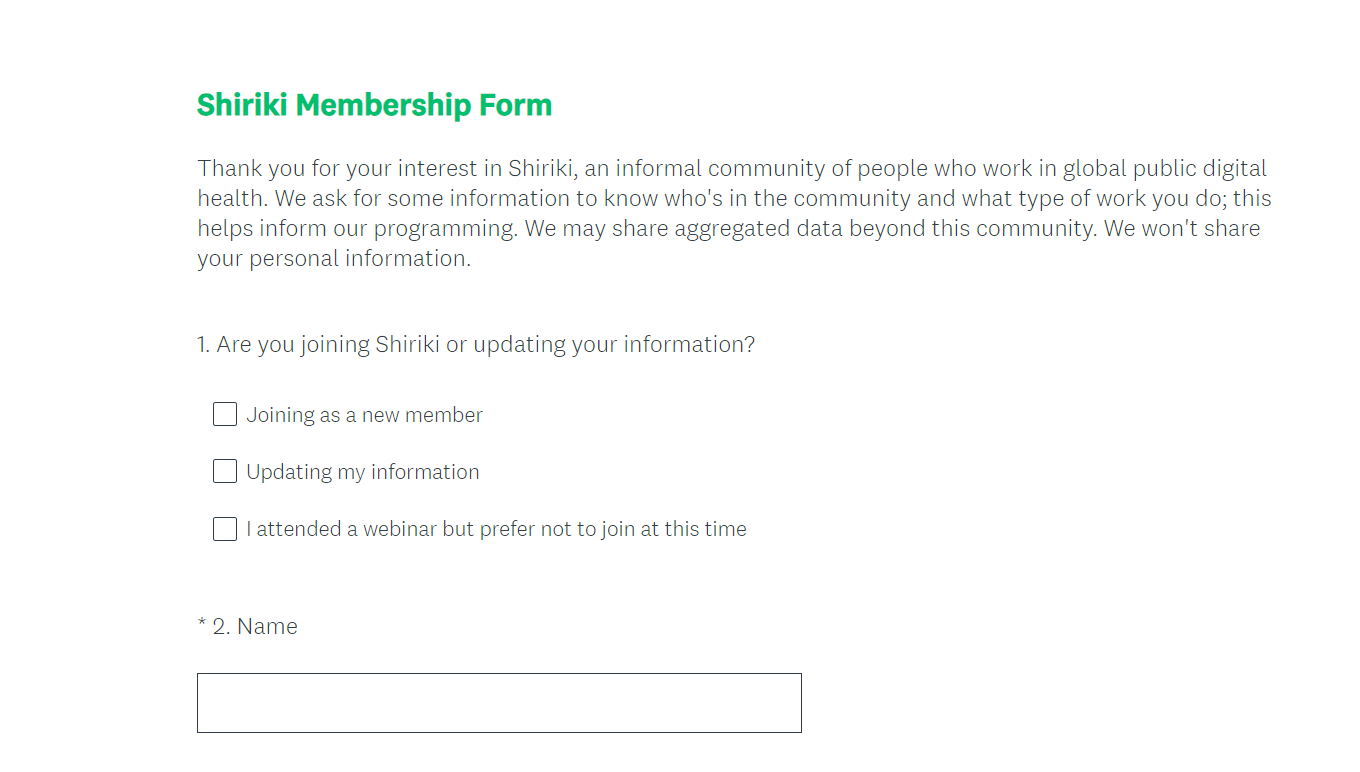
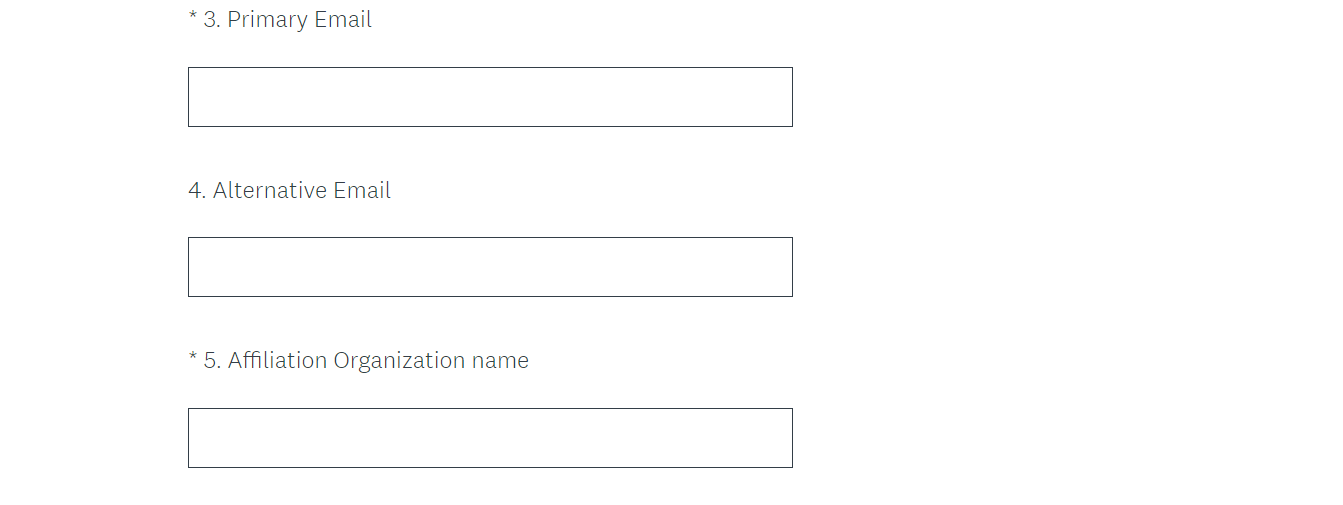
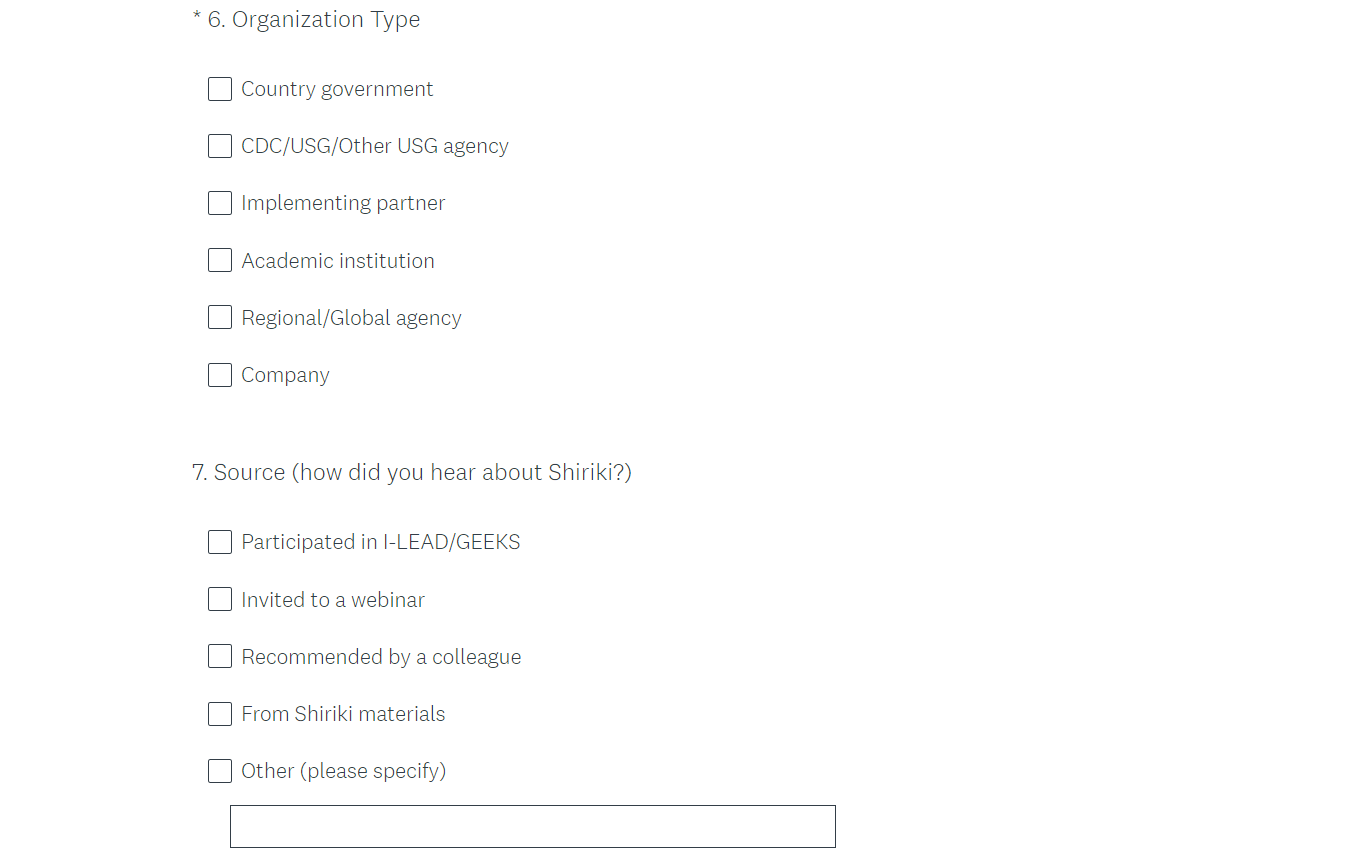

APPENDIX 2: Webinar Feedback Form
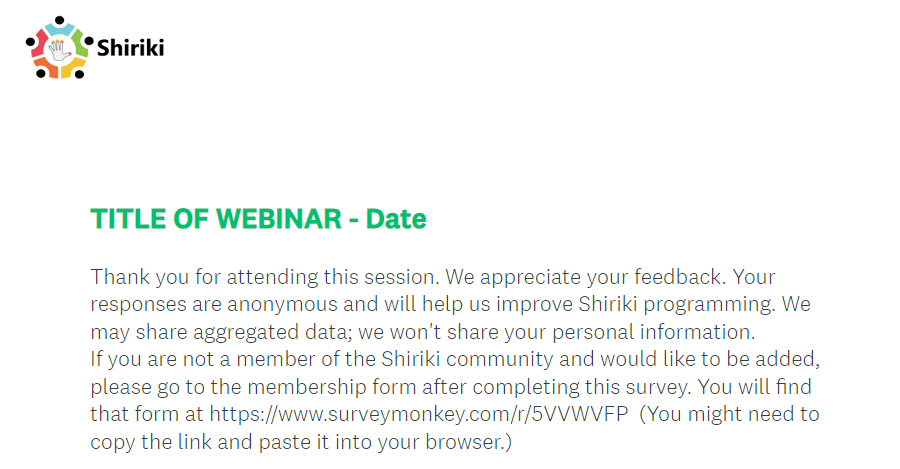
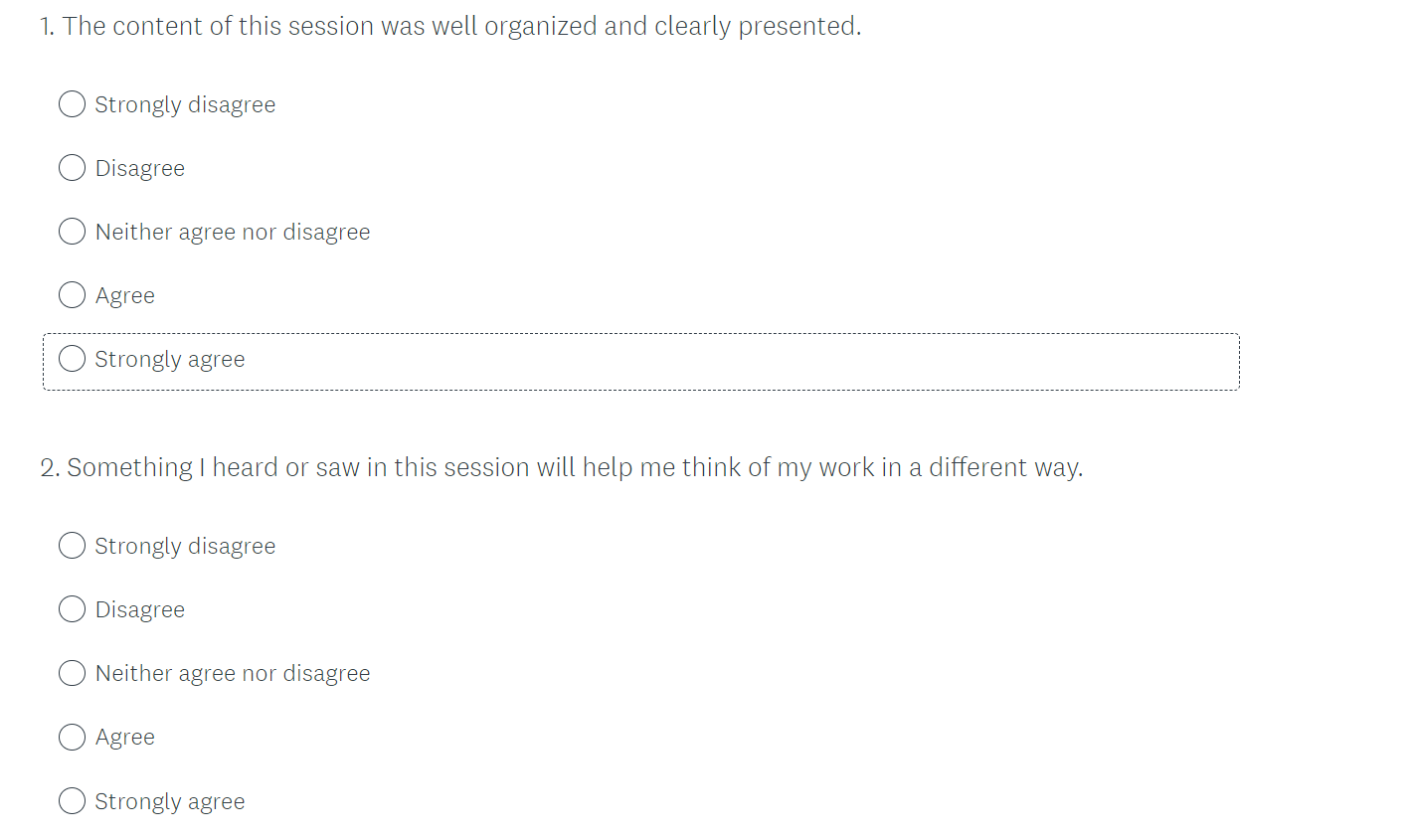
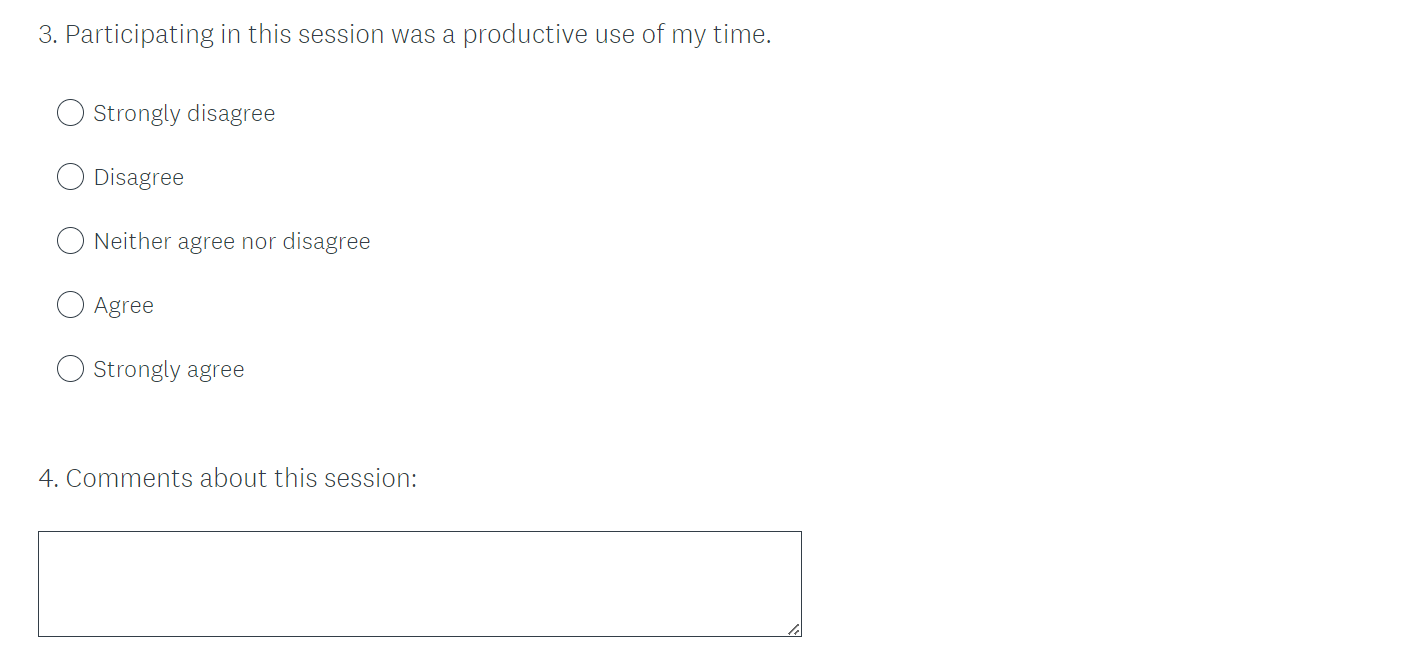
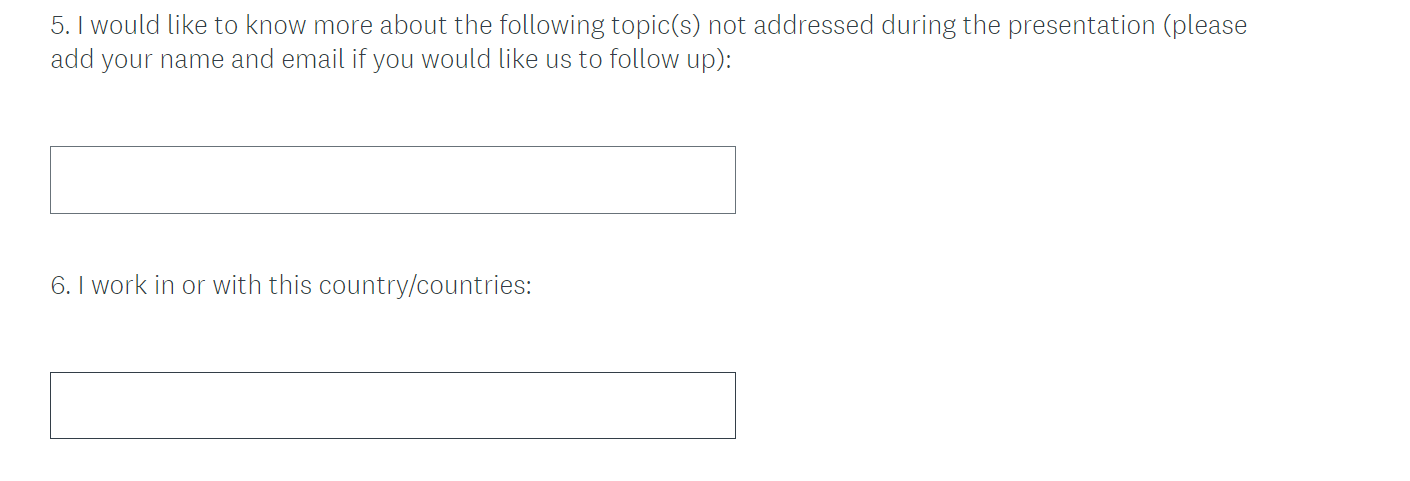
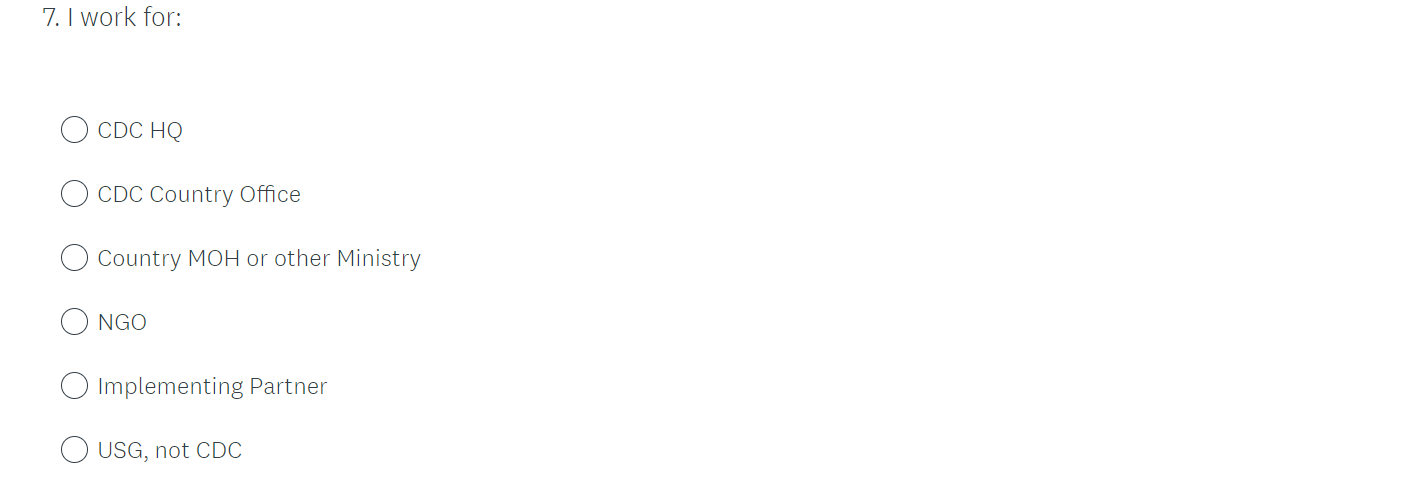
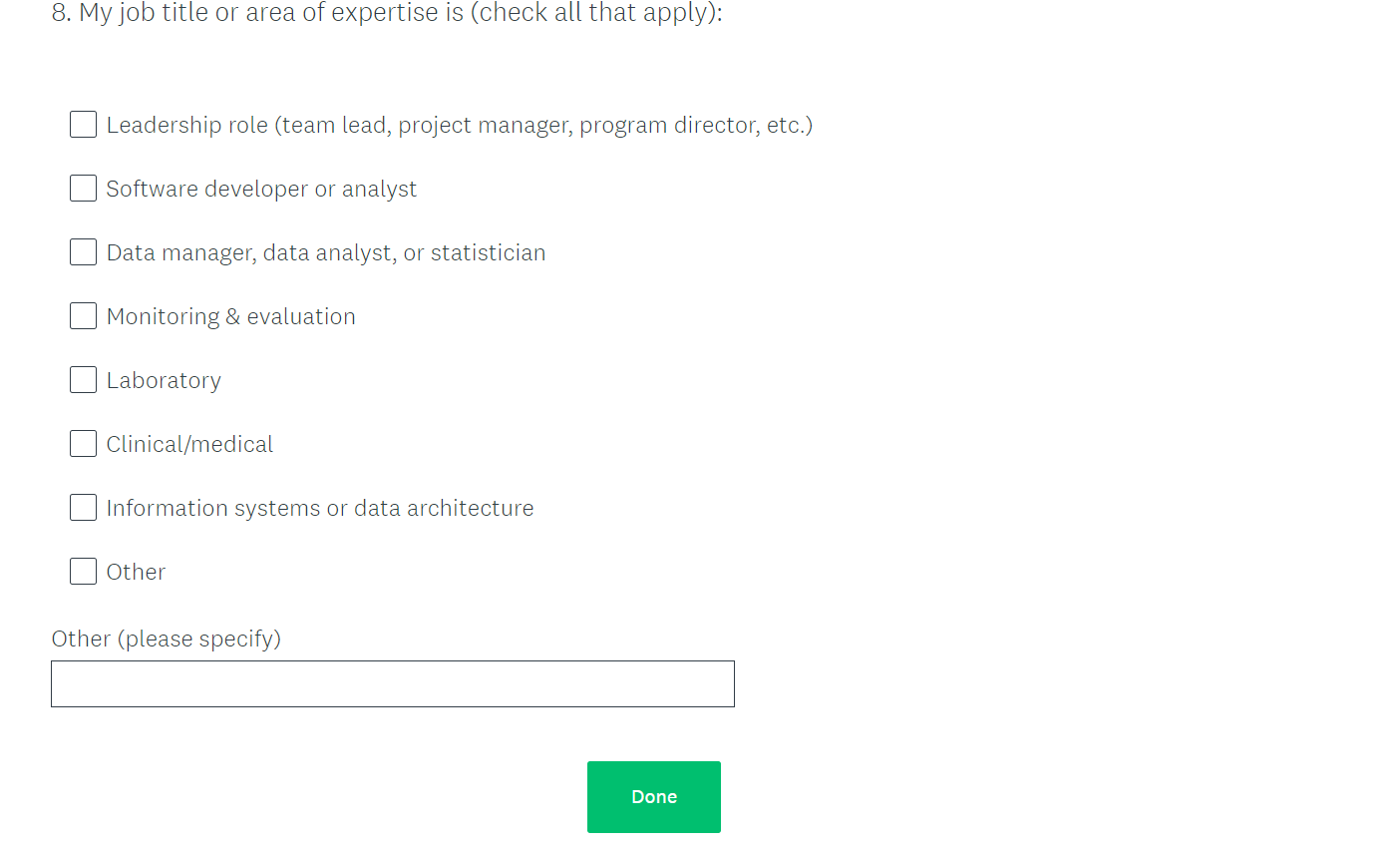
APPENDIX 3: Member Annual Survey
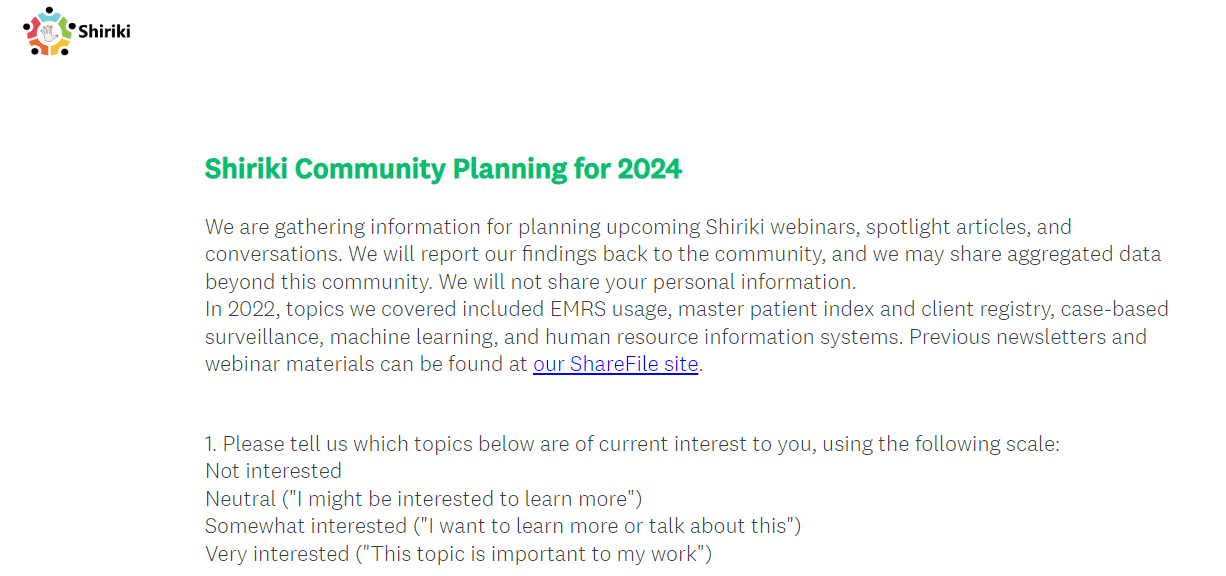
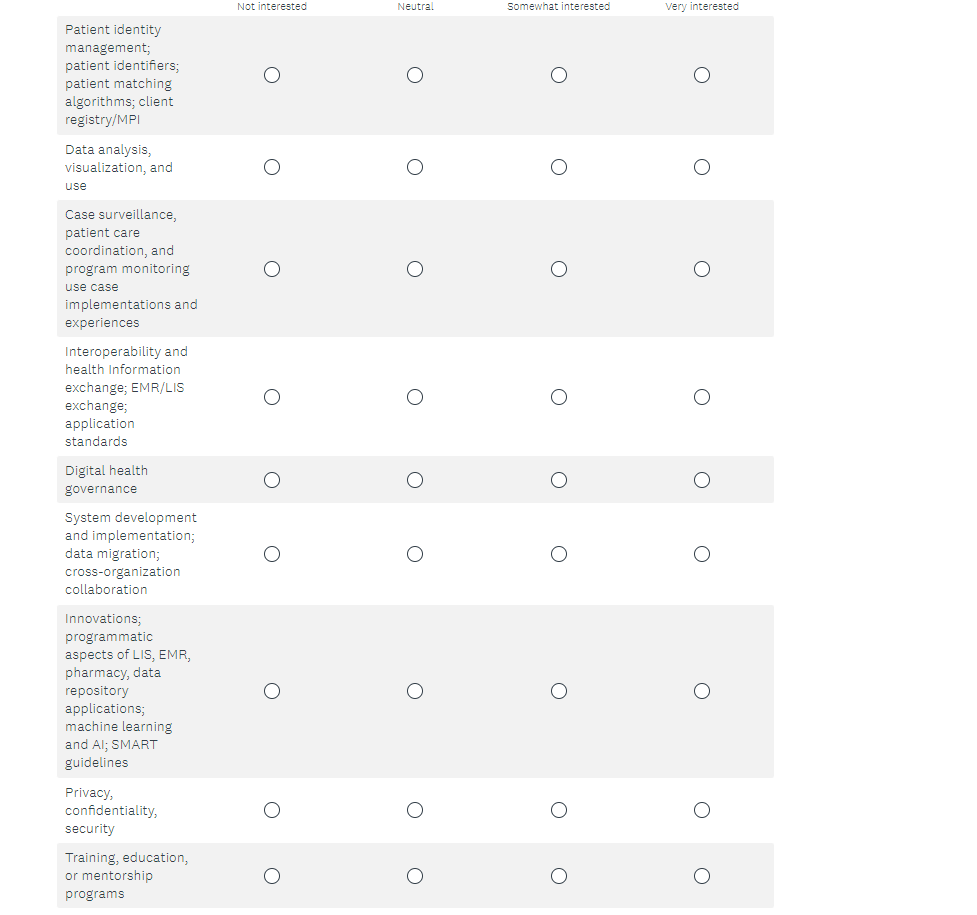

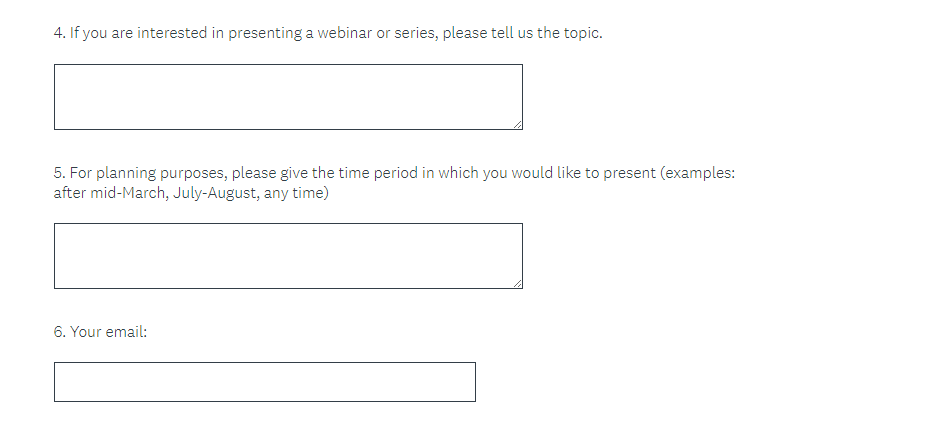
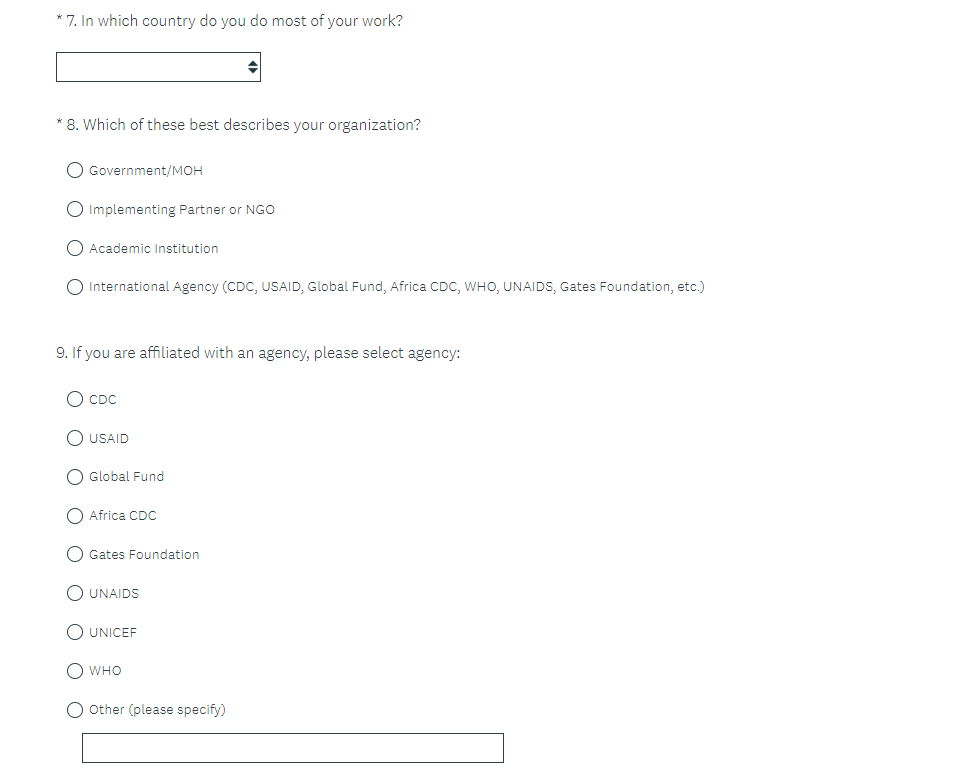
APPENDIX 4: Webinar Introduction Script
Hello, thank you for joining us for today’s webinar on [TOPIC]. We are recording the session and will make the recording, presentation, and other notes available. If you prefer not to be recorded, now is the time to exit. You’ll able to access the session later.
START RECORDING –
My name is [name] and I work with the Health Informatics Team in CDC’s Division of Global HIV &TB. We are meeting in the context of Shiriki, which is an informal community of people who work in global public health informatics with a focus on HIV and TB. The conversations we have in this community are led by members of the community and not necessarily by CDC.
If you are not a member of the community and would like to be, we have a very brief form to request membership. I’ll put a link to the membership form in the chat https://www.surveymonkey.com/r/5VVWVFP Also, if you are attending this session because someone forwarded you the meeting notice, would you mind taking a moment to let us know? You can use the same form to tell us where you are and how you learned about this.
[Brief description of webinar]
You are welcome to ask questions using the Zoom chat window. We’ll have plenty of time for conversation after the formal presentation. We do ask that you mute your mic unless you are speaking to everyone.
We have allotted 60 minutes for this session. We’ll make the transcript, chat, and recording available after the session as well. And I will now turn it over to [speaker/moderator].
CLOSING –We thank everyone for participating today and especially our presenters. We do ask that you provide us a little feedback on this session. We have a brief anonymous survey at the link posted: [link to feedback survey for this session]
You can find materials from this webinar here [link to Sharefile folder]
Please watch your email for more announcements. If you have a comment about Shiriki, please feel free to email us at shiriki@cdc.gov. Have a good day, everyone.
[Links are posted in the Zoom chat tool]
1 Wenger, E. (1998). Communities of practice: Learning, meaning and identity. Cambridge, UK: Cambridge University Press.
Shiriki Virtual Community Protocol, v. 1.5 |
October 3, 2023r |
|
|
Page |
|
| File Type | application/vnd.openxmlformats-officedocument.wordprocessingml.document |
| File Title | https://cdc.sharepoint.com/sites/CGH-DGHT-SIBeR/Protocol_Documents/27002-1548-R1-Reviewer-Inline-Edits-clean%201116.docx?d=wb258 |
| Author | Kariuki, James M. (CDC/DDPHSIS/CGH/DGHT) |
| File Modified | 0000-00-00 |
| File Created | 2025-05-19 |
© 2025 OMB.report | Privacy Policy